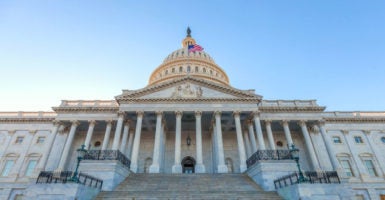Two thousand seventy-five dollars. That’s every American’s personal share of the fiscal year 2017 budget deficit. The total deficit? Six hundred sixty-six billion dollars.
It’s the American people who are on the hook for Congress’ incessant spending appetite. The good news, though, is that Congress has a chance to address deficits and overspending as we approach the fiscal year 2018 funding deadline.
While Congress is doing the critical work of reforming the U.S. tax code, it must not neglect opportunities to right-size government spending. As the late Milton Friedman reminded us, spending is the true tax. Deficit spending is simply deferred taxation, and today, both spending and deficits are on an upward trajectory.
With the expiration of the continuing resolution on Dec. 8, Congress will be faced with a major budget deadline to set spending for the remainder of fiscal year 2018.
Many lawmakers in Congress are considering seizing this opportunity to raise spending this year, particularly on defense. They also have an incentive to raise the budget caps, as any bump in spending above current law will cause automatic cuts to kick in.
Both of these incentives make a budget deal likely before year’s end, and it would likely put us on the path to further fiscal decline.
A Much-Needed Restraint
The Budget Control Act, passed in 2011, imposes fiscal discipline on Congress by limiting discretionary spending for both defense and nondefense to certain levels. The budget caps are set in law, and enforced by sequestration.
The law is far from perfect, and fiscal conservatives have struggled with repeated revisions by Congress to circumvent the spending limits put into law. But thus far, it has been effective at reining in spending.
The Budget Control Act needs several key reforms, which would strengthen the law and enhance transparency and accountability in budgeting for domestic and defense programs.
Congress should seriously consider adopting an overall discretionary spending cap instead of separate caps on defense and nondefense programs. Moreover, loopholes that allow for spending above the caps should be phased out, reserving any additional funding for true emergencies.
Congress should make sure any spending increases are fully offset to include any additional interest costs incurred over the 10-year budget window, with spending reductions taking place elsewhere. Offsetting this spending would help keep ballooning costs under control.
Importantly, Congress should make spending limits permanent and make them apply to mandatory programs as well as discretionary spending. Congress also must not allow spending limits to expire after 2021, as would happen under current law.
Further caps on autopilot entitlement programs will be required to truly rein in spending, as health care and old-age entitlements drive the vast majority of spending growth projected for the budget.
Despite its shortcomings, the Budget Control Act has overall been successful in controlling discretionary spending and in securing spending offsets whenever lawmakers have struck a deal to raise discretionary spending beyond what the law allowed. This has saved taxpayers hundreds of billions of dollars since the law’s inception.
Every year since 2011, Congress has revised the Budget Control Act caps in exchange for offsetting spending reductions and additional revenues (usually from government fee collection). Congress made real progress, despite the fact that billions of dollars in offsets were gimmicky and misrepresented the true costs of the revisions.
Strengthen the Budget Control Act. Don’t Weaken It.
The threat to America’s budget is even bigger this year.
Lawmakers may decide to forego offsetting spending reductions altogether, because cutting spending is hard work. But increasing overall spending would be careless this year and reckless in the long run.
What may seem like a small increase in spending in light of the $4 trillion federal budget will have much more far-reaching implications, driving up the debt and related interest costs over the long run, while growing the overall size of government.
Cutting spending, however, can help pave the way for the structural entitlement reforms that will ultimately be needed to square our fiscal situation. Congress must start somewhere.
And beyond budgetary concerns, inappropriate and wasteful federal spending imposes other costs on society. It hamstrings entrepreneurial ventures with excessive regulatory requirements and supplants appropriate private-sector functions with federal subsidies and loan guarantees, which distort U.S. economic activity and reduce potential economic growth.
Congress should right-size federal spending by following the president’s lead and provide for critical defense needs in a fiscally responsible manner.
There are savings in both mandatory and discretionary programs that can fully offset any Budget Control Act cap revision for defense. (A long list of these savings can be found in “Blueprint for Balance” and in the president’s budget proposal to Congress.)
Congress should also ensure that any Budget Control Act revision includes important reforms to strengthen the law and secures permanent spending limits.
Enforceable fiscal controls, like the spending limits in the Budget Control Act, are the nation’s best hope to drive federal spending down bit by bit, every year. Without such spending controls, deficit spending will eventually catch up to us.






























